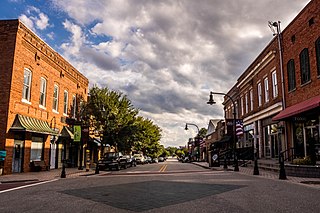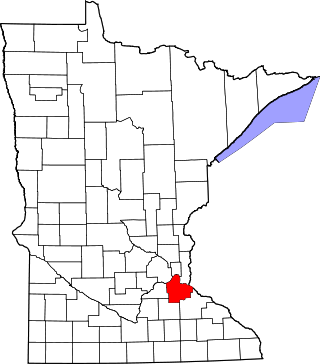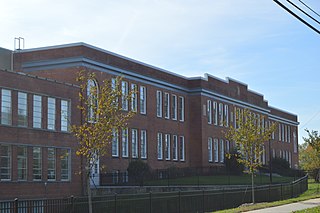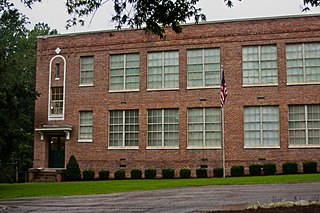
Cullowhee is a census-designated place (CDP) in Jackson County, North Carolina, United States. It is located on the Tuckasegee River, and the permanent population was 7,682 at the 2020 census up from 6,228 at the 2010 census.

Asheboro is a city in and the county seat of Randolph County, North Carolina, United States. The population was 27,156 at the 2020 census. It is part of the Greensboro-High Point Metropolitan Area of the Piedmont Triad and is home of the state-owned North Carolina Zoo.

Lumberton is a city in Robeson County, North Carolina, United States. As of 2020, its population was 19,025. It is the seat of Robeson County's government.

Wake Forest is a town in Franklin and Wake counties in the U.S. state of North Carolina; located almost entirely in Wake County, it lies just north of the state capital, Raleigh. At the 2020 census, the population was 47,601, up from 30,117 in 2010. It is part of the Raleigh metropolitan area. Wake Forest was the original home of Wake Forest University for 122 years before it moved to Winston-Salem in 1956.

Massey Hill Classical High School (MHCHS) is a high school in Fayetteville, Cumberland County, North Carolina. The main building of the Massey Hill Classical High School was built in 1925. It is a two-story brick building on a raised basement in the Classical Revival-style. What is now known as the Science Building was added in 1942 and eventually expanded to twelve classrooms. The gymnasium was built in 1947. The gymnasium has served as a community recreation center and is still used by the Recreation Department for evening basketball.

This is a list of the National Register of Historic Places listings in Dakota County, Minnesota. It is intended to be a complete list of the properties and districts on the National Register of Historic Places in Dakota County, Minnesota, United States. Dakota County is located in the southeastern part of the U.S. state of Minnesota, bounded on the northeast side by the Upper Mississippi River and on the northwest by the Minnesota River. The locations of National Register properties and districts for which the latitude and longitude coordinates are included below, may be seen in an online map.

The Joel Lane House, also known as Wakefield, was built in 1769 and is now a restored historic home and museum in Raleigh, North Carolina. It is the oldest dwelling in Wake County and contains collections of 18th century artifacts and period furnishings. The museum grounds include a detached middle-class home built circa 1790, a formal city garden, and a period herb garden. The house is named after Joel Lane, the "Father of Raleigh" and "Father of Wake County."

Glencoe is an unincorporated community in Alamance County, North Carolina, United States on North Carolina Highway 62, north-northeast of downtown Burlington.

The Carolina Inn is a hotel listed on the National Register of Historic Places on the campus of the University of North Carolina at Chapel Hill in Orange County, North Carolina, which opened in 1924. The Carolina Inn is a member of Historic Hotels of America, the official program of the National Trust for Historic Preservation.
The Woodlawn School is a historic school building located near Mebane, Alamance County, North Carolina. It is based on a design by architects Barrett & Thomson and built in two stages in 1911-12 and 1913. It is a Queen Anne style frame building with a gable roof and belfry. The listing included one contributing building and two contributing structures on 4.4 acres (1.8 ha). It was originally used as a school and community center and, after 1935, exclusively as a community center. A stage was added to one of the classrooms and the ballfield constructed in 1939, with Works Progress Administration funds.
Durham Hosiery Mill No. 15, also known as Mebane Yarn Mills, Inc. and Rockfish-Mebane Yarn Mills, Inc., is a historic hosiery mill building located at Mebane, Alamance County, North Carolina. It was built in 1922, and is a two-story, 20-bay, cast-in-place concrete mill building. Two-story concrete pilasters define each window bay. It features a centrally-placed, two-story, projecting square tower. A nine bay addition was built in 1966. The mill closed in 2001.

Lansing School is a historic school building located at Lansing, Ashe County, North Carolina. It was built in 1937-1938 by the Works Progress Administration, and is a two-story, 19 bay wide, building constructed of random coursed native granite blocks. The building features modest Colonial Revival style details. The building has a standing seam metal hipped roof with small gabled attic dormers. Also on the property is a two-story, four-bay, brick building built in 1952-53 to serve as high school classrooms.

Beaufort County Courthouse is a historic courthouse building located at Washington, Beaufort County, North Carolina. It was built about 1786, as a two-story, square brick building measuring 42 feet by 42 feet. It was later enlarged with a two-by rear extension and square clock tower. It is one of the earliest public buildings in North Carolina.

Avery Avenue School, also known as Catawba Valley Legal Services, is a historic school building located at Morganton, Burke County, North Carolina. It was built in 1923, and is a two-story, brick, crescent-shaped building. It has a polygonal center section features a pyramidal roof covered in mission tile and topped by a small belfry. The building housed a school until 1957 when it was converted to offices for Burke County.
Kelvin was a historic home located at Pittsboro, Chatham County, North Carolina. It was built about 1831, was a two-story, five bay Federal style single pile frame dwelling. The house had a gable roof and exterior end chimneys. It had a one-story addition built about 1838. It originally housed a private girls school established by wealthy landowner Colonel Edward Jones Kelvin. It has been demolished.
Siler City High School, also known as the Paul Braxton School, is a historic high school building located at Siler City, Chatham County, North Carolina. It was built in 1922, and is a two-story, T-shaped, five-bay school building with streamlined Art Deco design elements. It has a two-story-high auditorium wing. Also on the property are the contributing mid-1930s one-story brick woodworking shop building which now serves as a community center, a 1+1⁄2-story frame gymnasium begun in 1930, and an early 1930s dirt baseball field which was initially a football field.

Hillside Park High School, also known as Hillside High School, James A. Whitted Elementary School, and James A. Whitted Junior High School, is a historic school building for African-American students located at Durham, Durham County, North Carolina. The original Classical Revival portion dates to 1922 and is a T-shaped, two-story building on a full basement. A three-story red-brick, T-shaped Modern Movement style addition was built in 1954–1955, with a one-story-on-basement gymnasium rear wing. Also on the property is a contributing greenhouse built about 1960. The school served the African-American student population of Durham until 1970, when the schools were integrated.

West End School is a historic school building located at Henderson, Vance County, North Carolina. It was built in 1922, and is a two-story, 10 bay wide, red brick school. An addition was built about 1960, and is connected to the main school building by a 1 1/2-story hyphen. In 2003 the building was converted into 11 apartment units for the elderly.

The Glencoe is a historic apartment building located at Indianapolis, Indiana. It was built in 1902, and is a three-story, simplified Classical Revival style yellow brick building. It has a metal cornice, limestone detailing, and a brick parapet.

The Textile Heritage Museum is a history museum located in Glencoe, North Carolina along the Haw River. focused on the textile industry and life in mill towns in North Carolina and the American south. Located within the Glencoe Mill Village Historic District, which was added to the National Register of Historic Places in 1979, the museum is housed in the former management offices and company store built in 1880.



















